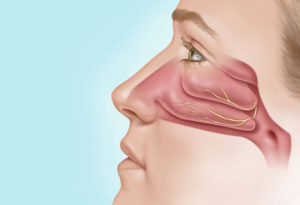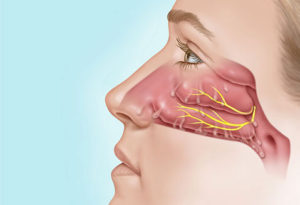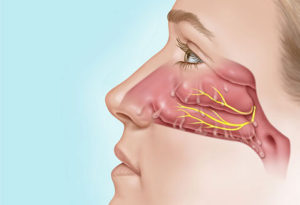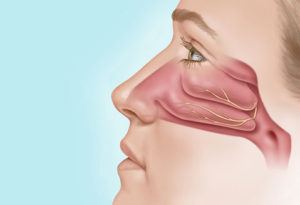Over 24 million Americans suffer from chronic rhinitis, a condition that typically leads to the following symptoms:1
- Frequent runny nose
- Post nasal drip
- Nasal congestion
- Throat clearing
Dr. Jourdy offers a unique treatment solution for adults with these frustrating chronic rhinitis symptoms using the patented ClariFix cryotherapy device to go to the source of the problem, the inflamed nasal lining and out of balance nerves in the nose.
Patients with chronic rhinitis are typically treated with nasal sprays and allergy management such as with antihistamines. However, some patients continue to have symptoms despite these treatments and may benefit from a newer therapy called ClariFix.
ClariFix is a minimally-invasive treatment that utilizes cold temperatures (cryotherapy) to stop the source of chronic rhinitis symptoms.
Chronic rhinitis symptoms can be caused by out of balance nerves, which may be sending too many signals to your nose, telling it to drip, run and swell more than necessary. The nerves may be stimulated by allergens or irritants in the air, changes in weather, medications, certain foods, or chronic health conditions. 2
Using cryotherapy, the ClariFix device delivers cold temperatures to these out of balance nerves in the back of the nose, interrupting the signals and reducing your symptoms.
ClariFix has many advantages:
- Can be performed in-office utilizing topical or local anesthesia
- Has a well-established safety profile
- The only FDA-cleared device for chronic rhinitis
Most patients begin to see improvement between 2 and 6 weeks after treatment. In a clinical study, patients reported a significant decrease in runny nose and nasal congestion with 4 out of 5 patients reporting long-lasting symptom relief. 3,4


Procedure Details
You can typically expect to spend about an hour in our office. Dr. Jourdy will start by numbing your nose with topical and local anesthetics. Once it is determined that you are adequately numb, the ClariFix device is placed in the back of the nose, and the cold therapy is applied to the targeted nerves. You may experience slight pressure, a cooling sensation in the nose and/or around the molars, or some discomfort during and/or after the treatment. However, the procedure is very well tolerated, and most patients typically return to normal activity the same day. As with any nasal treatment, you may experience increased sensitivity, congestion, and some discomfort after the treatment. The most common side effects associated with ClariFix cryotherapy are temporary increased congestion and transient pain or discomfort.

Before ClariFix

During ClariFix

After ClariFix
Preparing for your treatment
1
Know before you go
Prior to treatment, you should discuss any current medications you are taking as well as your medical history with your physician. Plan for a 1-hour appointment, and ask your physician if you will need someone to drive you home.
2
What to expect during the treatment
ClariFix Cryotherapy is typically performed right in your doctor’s office with only a local or topical anesthetic. The ClariFix device and an endoscope are placed into the back of your nose, where the out-of-balance nerves are located. The cold therapy is applied using a cooling probe and takes just a few minutes. You may feel slight pressure, a cooling sensation and some discomfort (though the treatment should not be painful).
3
What to expect after treatment
In general, there is minimal downtime and recovery. You may experience temporary increased congestion. Some discomfort is also possible, but will typically resolve the same day. Most patients begin to see improvement between 2 and 6 weeks post treatment.
4
ClariFix is safe
The most common side effects associated with ClariFix Cryotherapy are temporary increased congestion and transient pain or discomfort. In a clinical study, the ClariFix device was found to be well-tolerated with no device or procedure-related serious adverse events.5
References
- CDC: https://www.cdc.gov/nchs/fastats/allergies.htm. Accessed November 15, 2017
- Mayo Clinic: https://www.mayoclinic.org. Accessed November 15, 2017
- K162608, Data on File: A2014-02 Clinical Report, Arrinex.
- Hwang P, et al. “Cryosurgical Posterior Nasal Tissue Ablation for the Treatment of Rhinitis.” Int Forum Allergy Rhinol. 2017 Oct;7(10):952-956.
- Adverse events were those usually associated with post-cryosurgery in the nasal passageway and included: pain/discomfort, headache, facial pain, bleeding, dry nose, ear blockage. By day 90, symptoms had either resolved or were rated as mild.

